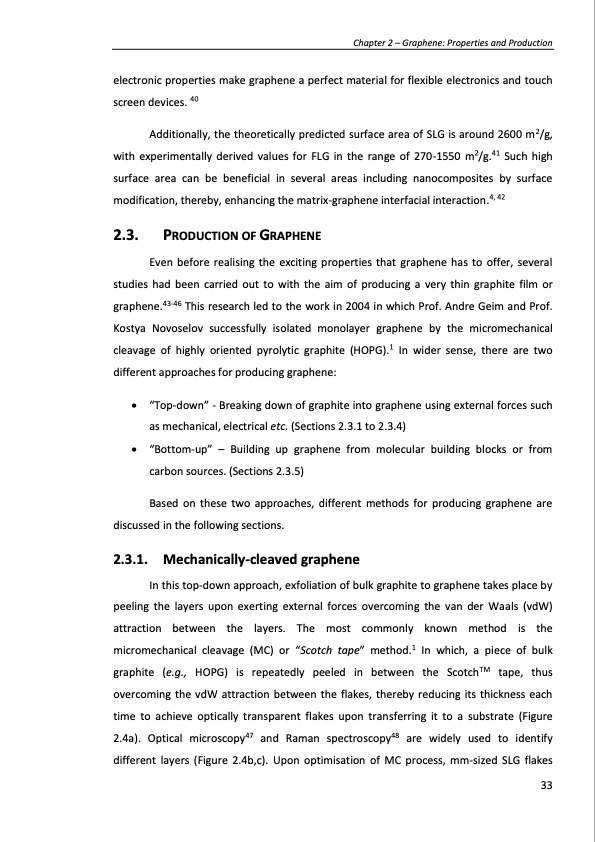
PDF Publication Title:
Text from PDF Page: 033
electronic properties make graphene a perfect material for flexible electronics and touch screen devices. 40 Additionally, the theoretically predicted surface area of SLG is around 2600 m2/g, with experimentally derived values for FLG in the range of 270-1550 m2/g.41 Such high surface area can be beneficial in several areas including nanocomposites by surface modification, thereby, enhancing the matrix-graphene interfacial interaction.4, 42 2.3. PRODUCTION OF GRAPHENE Even before realising the exciting properties that graphene has to offer, several studies had been carried out to with the aim of producing a very thin graphite film or graphene.43-46 This research led to the work in 2004 in which Prof. Andre Geim and Prof. Kostya Novoselov successfully isolated monolayer graphene by the micromechanical cleavage of highly oriented pyrolytic graphite (HOPG).1 In wider sense, there are two different approaches for producing graphene: “Top-down” - Breaking down of graphite into graphene using external forces such as mechanical, electrical etc. (Sections 2.3.1 to 2.3.4) “Bottom-up” – Building up graphene from molecular building blocks or from carbon sources. (Sections 2.3.5) Based on these two approaches, different methods for producing graphene are discussed in the following sections. 2.3.1. Mechanically-cleaved graphene In this top-down approach, exfoliation of bulk graphite to graphene takes place by peeling the layers upon exerting external forces overcoming the van der Waals (vdW) attraction between the layers. The most commonly known method is the micromechanical cleavage (MC) or “Scotch tape” method.1 In which, a piece of bulk graphite (e.g., HOPG) is repeatedly peeled in between the ScotchTM tape, thus overcoming the vdW attraction between the flakes, thereby reducing its thickness each time to achieve optically transparent flakes upon transferring it to a substrate (Figure 2.4a). Optical microscopy47 and Raman spectroscopy48 are widely used to identify different layers (Figure 2.4b,c). Upon optimisation of MC process, mm-sized SLG flakes Chapter 2 – Graphene: Properties and Production 33PDF Image | PRODUCTION AND APPLICATIONS OF GRAPHENE AND ITS COMPOSITES

PDF Search Title:
PRODUCTION AND APPLICATIONS OF GRAPHENE AND ITS COMPOSITESOriginal File Name Searched:
graphene-production-applications.PDFDIY PDF Search: Google It | Yahoo | Bing
Salgenx Redox Flow Battery Technology: Power up your energy storage game with Salgenx Salt Water Battery. With its advanced technology, the flow battery provides reliable, scalable, and sustainable energy storage for utility-scale projects. Upgrade to a Salgenx flow battery today and take control of your energy future.
| CONTACT TEL: 608-238-6001 Email: greg@infinityturbine.com | RSS | AMP |